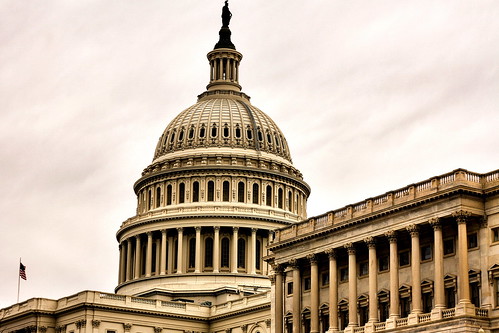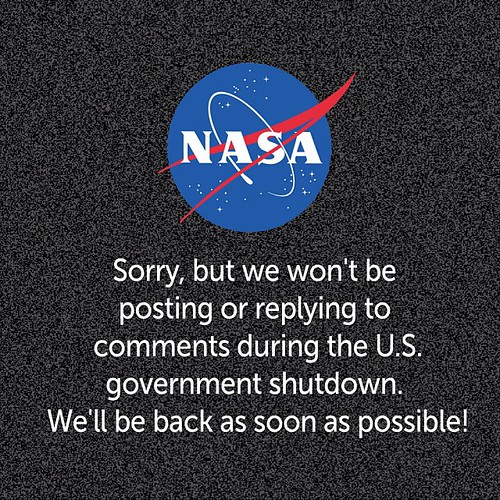When you work in DC, the ongoing drama of the budget stalemate and government shutdown is a part of your daily life. The metro is emptier, traffic is lighter, and all our wonderful museums and monuments are closed.
Many meetings with legislative and executive branch staff are being cancelled. The specter of uncertainty hangs in the air. The newspapers are full of stories about weddings at the Jefferson

Things have slowed down dramatically on Capitol Hill as Congress deals with the shutdown of the federal government. Photo: Flickr user Phil Roeder
Memorial that aren’t taking place, or disappointed tourists wandering the city and finding shuttered attractions.
But the shutdown has a lot of casualties, and government science is one of them. The shutdown doesn’t just stop the flow of money in government; it stops the flow of ideas. That impoverishes us more than we can know.
Before the shutdown, the Office of Management and Budget required each agency to develop contingency plans for how they would operate during a shutdown.
Those plans by themselves are extensive and comprehensive, and likely took a lot of federal staff resources that could have been better spent protecting public health and safety and the environment, and pursuing crucial federal research goals.
But reading the plans for just a few federal science agencies, you’re struck by how much the federal science effort will be curtailed, even by a brief shutdown.
National Science Foundation
At the National Science Foundation, the plan is to shut down nearly all operations, furloughing 2,000 employees and contractors, and leaving a skeleton crew of 30. Recipients of NSF grants can continue, as long as the recipients don’t run out of money or need any help from NSF staff.
The NSF will retain communication with researchers in the Arctic and Antarctic for obvious reasons – they don’t want to leave them literally out in the cold should an emergency arise.
Department of Health and Human Services
The sprawling Department of Health and Human Services is the umbrella agency for a number of the nation’s federal science agencies: the National Institutes of Health, the Centers for Disease Control, and the Food and Drug Administration.
Overall, HHS will be furloughing more than half its employees, more than 40,000 staffers in all.
At the National Institutes of Health, anyone enrolled in a clinical trial will continue to receive care. As the contingency plan points out, individuals who undergo “investigational procedures” at the NIH Clinical Center have run out of other options for medical treatment. However, NIH won’t be accepting any new patients, a terrible blow to those who had looked to the facility as their last hope.
But the 8,000 or so NIH staff working in the more than 1,100 NIH research labs would be idled. Instead, 734 staffers would be on hand to destroy some research materials that would be useless if research protocols can’t be maintained, and to maintain cell lines and other research materials that are “invaluable” and must be saved. Consider the potentially life-saving experiments that won’t be done or may have to be re-done because of the shutdown.
NIH also is responsible for the safekeeping of 1.35 million lab mice, 390,000 fish, 63,000 rats, and 3,900 primates. Two dozen NIH facilities use these animals for research purposes. While the scientists won’t be doing research work, the animals have to be cared for. As the plan notes: “Many of these animals are priceless and have taken generations to breed.”
The CDC won’t be planning for the flu season, just around the corner. Nor will it be able to use its gold-standard science to help states detect disease outbreaks.
The FDA won’t be doing routine food safety inspections, the monitoring of food imports, and “the majority of the laboratory research necessary to inform public health decision-making.”
Environmental Protection Agency
Scientists at the Environmental Protection Agency also will be sidelined during a shutdown. EPA Administrator Gina McCarthy last week stated that a budget stalemate “will mean that EPA effectively shuts down.” Federal officials had projected that fewer than 1,000 of the EPA’s more than 16,000 employees will be working during the shutdown.

NASA has furloughed 97% of its employees and won’t be using social media platforms, like Instagram, during the shutdown. Photo: NASA
Halting the flow of ideas
The shutdown disrupts even more than federal science that generates research products and informs oversight and regulation. It also disrupts the communication of federal data to scientists who work outside the government. If you’re a scientist working anywhere in the country, or the world, for that matter, and your work relies on access to up-to-data federal information, you may be out of luck.
For example, the National Climate Data Center, based in Asheville, N.C., was closed on Monday, shutting down a vital pipeline for researchers outside the government.
That closure, combined with the furloughs of thousands of scientists at NASA, EPA, NOAA, and the Department of Interior, also means that federal efforts to better understand and predict climate change, hurricanes and other natural disasters, are largely on hold.
The halt of federal funds even stops unpaid experts who advise the government on scientific and other matters. Effective October 1, federal advisory panels working on issues as diverse as dietary guidelines to climate change were stopped dead in their tracks.
Even if the shutdown doesn’t last long, its impact on federal science will have long-lasting effects. You can’t recapture lost time, or easily calculate the losses that stem from scientific breakthroughs that didn’t happen, or happened late, or identify the promising federal researchers who lose heart.
